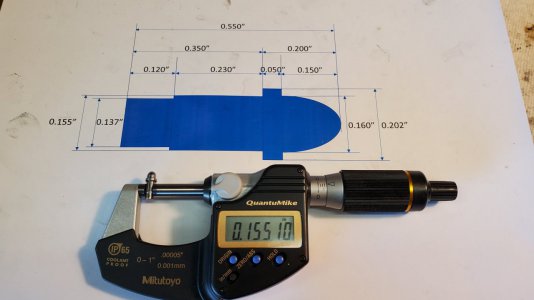- Joined
- Oct 7, 2020
- Messages
- 2,116
I watched the video, great info.
Thanks
Thanks
Jeeper, he sounds like a real ray of sunshine!After watching the video, one comment; he takes his last cut to finish size without any measuring before taking his cut on the whole length of the finished surface; as an apprentice, I got a pointed lecture from the foreman (after cutting a workpiece a bit under the stated tolerance; his suggestion to avoid such in the future was to cut a short distance into the cut, long enough to take an accurate measurement and make sure it was not undersize, if it was, make adjustments to bring it on the proper size, he said few parts would be ruined by a very short undersized portion.. I cannot say that this foreman has a particularly fond place in my memory, he was a particularly rigid man, raised in a railroad shop, a pretty brutal place and he reflected that; he did not particularly like me and the feeling was reciprocated, but I do owe him for several appropriate suggestions.
RIP Elmer Richards. When I told him in later years that I was opening my own business, he told me that I had nowhere the necessary experience to do so, I guess he was wrong!

If you are going to take light cuts with an insert, make sure it is designed for that. Otherwise it might be inclined to skate/burnish rather than cut. After watching Stefan's video I started using that method. It works! It is especially true when using inserts that normally require some depth of cut to work well. If your insert is at all worn it will require more depth of cut to work well. All this is likely even more true if your lathe isn't super rigid.then take fairly light finishing cuts to size
He had previously worked as a boss at Hall Scott Motors in Berkley as a boss, he had such problems with his subjects that he had a nervous breakdown, came to our shop to mend, said he never wanted to boss again, couldn't help himself, I guess.Jeeper, he sounds like a real ray of sunshine!
This is why I prefer positive rake ground inserts for all but roughing.If you are going to take light cuts with an insert, make sure it is designed for that. Otherwise it might be inclined to skate/burnish rather than cut. After watching Stefan's video I started using that method. It works! It is especially true when using inserts that normally require some depth of cut to work well. If your insert is at all worn it will require more depth of cut to work well. All this is likely even more true if your lathe isn't super rigid.
"Hey Onee!After watching the video, one comment; he takes his last cut to finish size without any measuring before taking his cut on the whole length of the finished surface; as an apprentice, I got a pointed lecture from the foreman (after cutting a workpiece a bit under the stated tolerance; his suggestion to avoid such in the future was to cut a short distance into the cut, long enough to take an accurate measurement and make sure it was not undersize, if it was, make adjustments to bring it on the proper size, he said few parts would be ruined by a very short undersized portion.. I cannot say that this foreman has a particularly fond place in my memory, he was a particularly rigid man, raised in a railroad shop, a pretty brutal place and he reflected that; he did not particularly like me and the feeling was reciprocated, but I do owe him for several appropriate suggestions.
RIP Elmer Richards. When I told him in later years that I was opening my own business, he told me that I had nowhere the necessary experience to do so, I guess he was wrong!
I guess I was mainly curious if the .004 extra was normal on a .050 cut. There is a few things for me to check. And make a way to lock the cross slide.
